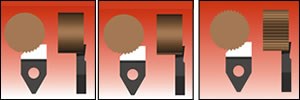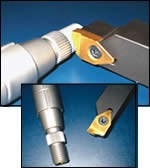Serrating On The Lathe
If you are one of those firms doing serrating as a separate operation, you’ll be pleased to learn that there is now a serration shave tool that enables you to perform the serrating as just another operation on your CNC lathe.
In the past, putting serrtions in a part required an additional operation on a milling machine or a broach. That required a separate setup on an additional machine tool, additional labor cost (for the mill or broaching machine operator) and, of course, additional handling, movement and possibly temporary storage of the parts between operations. Also, before the serrating operation was performed, the part might have required an intermediate cleaning operation.
If you are one of those firms doing serrating as a separate operation, you’ll be pleased to learn that there is now a serration shave tool that enables you to perform the serrating as just another operation on your CNC lathe. The “Serration Shave Tool” is made by Schwanog and available in the United States from GST Tooling Corp. (Roselle, Illinois). The tool consists of a replaceable insert and matching toolholder. The TiN-coated high speed steel insert consists of a quarter-circle with six teeth. Only the first or lead tooth has a complete (finished) tooth profile. On each of the remaining five teeth, the tooth profile is increasingly less defined.
The tool mounts in the lathe’s turret and forms the serrations in successive Z-axis strokes along the part. At the beginning of the process, the spindle remains stationary while the tool makes three passes that form the first five teeth in progressive stages of development and a fully formed sixth tooth. Then the spindle indexes to the next tooth location (a C axis is required), where the first five teeth are increasingly formed and the last tooth is completed. Each time the spindle indexes to the next tooth position and the turret strokes the part, one tooth is completed. The process continues until the part indexes full-circle and the serrations are completely formed.
The procedure is both easy and fast. For example, the serrating of a part made of 1045 steel can be achieved on a conventional CNC lathe with C-axis capability in as little as 7 seconds. Incorporating the serrating operation as a lathe operation simplifies processing of the part: The operation does not have to be performed on an additional machine, eliminating the cleaning of the part between operations, the setup and operating costs of the additional machine, and additional part handling. Best of all, parts exit the lathe completely machined and ready for cleaning and delivery to the customer.
GST reports that the serrating inserts can be resharpened by the end user, although provisions must be made for the recentering the tool. Removal of the insert is fast and easy because it is secured by a single screw. Because the toolholder is simply a stick tool, the serrating tool can be used on multi-spindle and single-spindle machines with C-axis capability.
Related Content
-
Cutting Tool Considerations for Hydraulic Port Machining
Indexable insert cutting tools can boost the efficiency of port machining processes by creating multiple features in a single operation.
-
The Ins and Outs of Inserts
Understanding how inserts are made provides valuable insight into how their performance can be optimized.
-
Deep-Hole Advice Using Replaceable-Insert Drills
A cautious approach, modern thinking, offline presetting and attention to coolant and chips unlock the potential of the latest replaceable-insert drills for deep-holemaking applications.

















